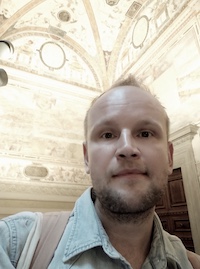Máté Csanda

Máté Csanda
Máté Csanda is a PhD candidate at the Department of Art History. After his secondary school education, he first studied fine arts – free painting and graphics at the Düsseldorf Art Academy (from 2006 in the studio of Prof. Markus Lüpertz), then graphics and illustration at the Kunsthochschule Kassel (in the studio of Prof. Hendrik Dorgathen, graduated with a diploma). Followed by a second degree in art history (Bachelor and Master) at the Institute of Art History at the University of Vienna. Since April 2020 research assistant at the same institute (also PraeDoc assistant under Prof. Sebastian Egenhofer) with regular teaching activities.
Research interests: Theories of the archive, theories of irony; transitology (in the context of "East-Central European" art historiographies), politically engaged, activist-oriented, critical-subversive positions in modern and contemporary art - not only but especially in the context of deconstruction attempts of nationalist and identitarian memory narratives in Hungary / Slovakia and "East-Central Europe"; public art and the politicity of public spaces
Current research project: In my ongoing dissertation project, I am dealing with contemporary artworks from Hungary that operate predominantly in the medium of docufiction – and which perform a critical-deconstructivist work on ethnic-nationalist identity narratives and their ideological appropriation.
I regard the works (created after 2000) as prismatic visual boxes – dispositives offering us a critical view into the Hungarian archive of memory and, as I see it, having the potential to criticize myths and ideologies. I consider the works as „theoretical objects“ (Mieke Bal and Hubert Damisch) – which are able to reveal to us the „genuinely Hungarian“ anomalies and „construction errors“ of Hungarian (ethnic) nationalism through the multiple, subtle ( in any case critically meaningful) interweaving of different contexts, discourses (often local, dispersed, subaltern) memories and narratives. The conceptual focus of the work is primarily on the logic of construction, the historicity (and often generally the "falsity") of the ethnic-nationalist identity concepts and ideologems of the 1990s and our present in the Hungarian context. However, the topic also includes at least as much criticism of the political instrumentalization of the relevant narratives (during the 40 years of state socialism) during the 1990s, but especially after 2022/2010. The role or ideological "complicity" of various visual media, genres and forms of mediation of visual content is also critically addressed. One of the central questions of my work is: what do these works provide, to what extent (and for whom) are they critical, subversive and revelatory? How can their epistemological, sometimes institutional, sometimes linguistic-critical (or even didactic) potential be explored? In what way are certain forms and figures of "aesthetic thinking" or argumentation inherent to them? What procedures and patterns of thought can their specifically aesthetic model-like nature (or the paradigm of artistic research) create which academic historiography would be denied? How can these works link contexts, memories and narratives of academically sanctioned historiography, public history and (government-controlled) identity and memory politics - but also identity constructions of small, marginalized groups (who struggle for visibility in the public sphere) - and perform work that is critical of discourse and ideology in the medium of documentary or "docu-fictional"? How do they also manage to give visibility to subaltern actors, positions and marginalized or even suppressed narratives? The backbone of the work will be formed by three detailed close readings. In these, the works of Szabolcs KissPál and the artist collective LittleWarsaw (András Gálik, Bálint Havas) in particular will be analyzed - and, in addition to examining their formal, narrative (etc.) procedures, their subversive and revelatory (perhaps even political) potential will be questioned.
Workshops and talks (selection)
- Reactionary Remodeling Public Space — The Kossuth Square in Budapest || Lecture given on AgorAkademi International Seminar Monuments and Public Space in Mutual Transformation, Columbia Global Centers, Paris, 12. November 2021; Org. by Prof. Nilüfer Göle // EHESS – L´École des Hautes Études en Sciences Sociales & CESPRA – Centre d´Études Sociologiques et Politiques Raymond Aron
- Understanding 1989 in East-Central European Art. War vs. Revolution – led by the Piotr Piotrowski Center for Research on East-Central European Art at Adam Mickiewicz University in Poznań, funded by the Getty Foundation's Connecting Art Histories project (Sarajevo – Bucharest – Poznań), project leads: Magdalena Radomska & Edit András, 2023/2024
- The Družba and Its Afterlife – Bratislava's Freedom Square (formerly Gottwald Square) as Stage and Litmus Paper of (Post)Socialist Body Politics – Rethinking the (Post-)Socialist Body. Art, Theory & Politics || Florence, 28 September to 30 September, Kunsthistorisches Institut in Florenz – Max-Planck-Institut. Transdisciplinary Workshop org. by Oliver Aas, Hana Gründler and Magdalena Nieslony
Publications
- Flügelspannweite und Projektionsfläche: Ideologie und Leibhaftigkeit. Szabolcs KissPál: The Rise of the Fallen Feather (2016) – ein Annäherungsversuch [Wingspan and projection surface: ideology and corporeality. Szabolcs KissPál: The Rise of the Fallen Feather], in: Acta Ethnologica Danubiana 22 (2020), Jahrbuch des Forschungszentrums für Europäische Ethnologie, Komárom–Komárno, 111-137.
- Tracing the Way to Traces – Notes on the Work of Erika Szőke [Na stopy odkazujúce stopy – poznámky k tvorbe Eriky Szőke], in: Profil 2/2021, Bratislava, 22-33.
- Németh Ilona. A szavak és dolgok hallgatag beszédessége [Ilona Németh. The quiet eloquence of things and words], in: Új Szó, Vol. LXX., No. 168, 22. July 2017, 14-15.
Curatorial projects (selection)
- November 2017 – January 2018
András Cséfalvay – Martin Piaček: Warm Earth Faint Sound || SNM - Múzeum kultúry Maďarov na Slovensku Museum of Hungarian Culture in Slovakia, Bratislava - January – February 2020
Erika Szőke: SPECULUM MUNDI. Domáce práce a iné významotvorne postupy / Homeworks, houseworks and other meaningproducing activities. Galéria MEDIUM, Bratislava. - October – November 2022
Csilla Nagy & Erika Szőke / Blednúca zem (Fading ground), At Home Gallery (former Synagogue), Šamorín, Slovakia
